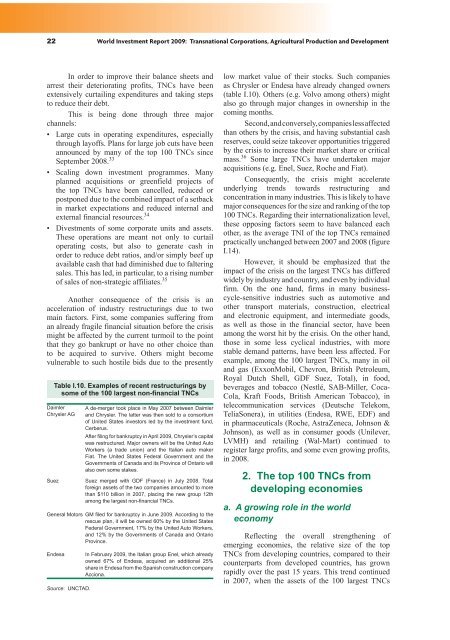World Investment Report 2009: Transnational Corporations - Unctad
World Investment Report 2009: Transnational Corporations - Unctad
World Investment Report 2009: Transnational Corporations - Unctad
You also want an ePaper? Increase the reach of your titles
YUMPU automatically turns print PDFs into web optimized ePapers that Google loves.
22 <strong>World</strong> <strong>Investment</strong> <strong>Report</strong> <strong>2009</strong>: <strong>Transnational</strong> <strong>Corporations</strong>, Agricultural Production and Development<br />
In order to improve their balance sheets and<br />
arrest their deteriorating profits, TNCs have been<br />
extensively curtailing expenditures and taking steps<br />
to reduce their debt.<br />
This is being done through three major<br />
channels:<br />
�� ������ ����� ��� ���������� �������������� �����������<br />
through layoffs. Plans for large job cuts have been<br />
announced by many of the top 100 TNCs since<br />
September 2008. 33<br />
�� �������� ����� ����������� ������������ �����<br />
planned acquisitions or greenfield projects of<br />
the top TNCs have been cancelled, reduced or<br />
postponed due to the combined impact of a setback<br />
in market expectations and reduced internal and<br />
external financial resources. 34<br />
�� ������������ ��� ����� ���������� ������ ���� ��������<br />
These operations are meant not only to curtail<br />
operating costs, but also to generate cash in<br />
order to reduce debt ratios, and/or simply beef up<br />
available cash that had diminished due to faltering<br />
sales. This has led, in particular, to a rising number<br />
of sales of non-strategic affiliates. 35<br />
Another consequence of the crisis is an<br />
acceleration of industry restructurings due to two<br />
main factors. First, some companies suffering from<br />
an already fragile financial situation before the crisis<br />
might be affected by the current turmoil to the point<br />
that they go bankrupt or have no other choice than<br />
to be acquired to survive. Others might become<br />
vulnerable to such hostile bids due to the presently<br />
Table I.10. Examples of recent restructurings by<br />
some of the 100 largest non-financial TNCs<br />
Daimler<br />
Chrysler AG<br />
A de-merger took place in May 2007 between Daimler<br />
and Chrysler. The latter was then sold to a consortium<br />
of United States investors led by the investment fund,<br />
Cerberus.<br />
After filing for bankruptcy in April <strong>2009</strong>, Chrysler’s capital<br />
was restructured. Major owners will be the United Auto<br />
Workers (a trade union) and the Italian auto maker<br />
Fiat. The United States Federal Government and the<br />
Governments of Canada and its Province of Ontario will<br />
also own some stakes.<br />
Suez Suez merged with GDF (France) in July 2008. Total<br />
foreign assets of the two companies amounted to more<br />
than $110 billion in 2007, placing the new group 12th<br />
among the largest non-financial TNCs.<br />
General Motors GM filed for bankruptcy in June <strong>2009</strong>. According to the<br />
rescue plan, it will be owned 60% by the United States<br />
Federal Government, 17% by the United Auto Workers,<br />
and 12% by the Governments of Canada and Ontario<br />
Province.<br />
Endesa In February <strong>2009</strong>, the Italian group Enel, which already<br />
owned 67% of Endesa, acquired an additional 25%<br />
share in Endesa from the Spanish construction company<br />
Acciona.<br />
Source: UNCTAD.<br />
low market value of their stocks. Such companies<br />
as Chrysler or Endesa have already changed owners<br />
(table I.10). Others (e.g. Volvo among others) might<br />
also go through major changes in ownership in the<br />
coming months.<br />
Second, and conversely, companies less affected<br />
than others by the crisis, and having substantial cash<br />
�������������������������������������������������������<br />
by the crisis to increase their market share or critical<br />
mass. 36 Some large TNCs have undertaken major<br />
������������������������������������������������<br />
Consequently, the crisis might accelerate<br />
underlying trends towards restructuring and<br />
concentration in many industries. This is likely to have<br />
�������������������������������������������������������<br />
������������������������������������������������������<br />
these opposing factors seem to have balanced each<br />
other, as the average TNI of the top TNCs remained<br />
practically unchanged between 2007 and 2008 (figure<br />
I.14).<br />
��������� ��� ������� ��� ����������� ����� ����<br />
impact of the crisis on the largest TNCs has differed<br />
widely by industry and country, and even by individual<br />
firm. On the one hand, firms in many businesscycle-sensitive<br />
industries such as automotive and<br />
other transport materials, construction, electrical<br />
and electronic equipment, and intermediate goods,<br />
as well as those in the financial sector, have been<br />
among the worst hit by the crisis. On the other hand,<br />
those in some less cyclical industries, with more<br />
stable demand patterns, have been less affected. For<br />
example, among the 100 largest TNCs, many in oil<br />
and gas (ExxonMobil, Chevron, British Petroleum,<br />
������ ������ ������� ���� ������ �������� ��� ������<br />
beverages and tobacco (Nestlé, SAB-Miller, Coca-<br />
Cola, Kraft Foods, British American Tobacco), in<br />
telecommunication services (Deutsche Telekom,<br />
TeliaSonera), in utilities (Endesa, RWE, EDF) and<br />
in pharmaceuticals (Roche, AstraZeneca, Johnson &<br />
Johnson), as well as in consumer goods (Unilever,<br />
LVMH) and retailing (Wal-Mart) continued to<br />
register large profits, and some even growing profits,<br />
in 2008.<br />
2. The top 100 TNCs from<br />
developing economies<br />
a. A growing role in the world<br />
economy<br />
Reflecting the overall strengthening of<br />
��������� ����������� ���� ��������� ����� ��� ���� ����<br />
TNCs from developing countries, compared to their<br />
counterparts from developed countries, has grown<br />
rapidly over the past 15 years. This trend continued<br />
in 2007, when the assets of the 100 largest TNCs

















